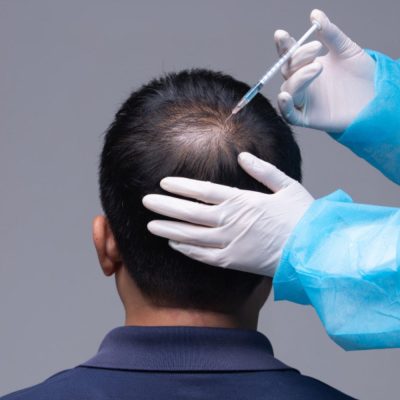Platelet-Rich Plasma (PRP) Therapy for Hair Restoration
Platelet-Rich Plasma (PRP) therapy is an advanced, non-surgical treatment designed to stimulate hair growth and improve hair thickness using the patient’s own blood components. By harnessing the body’s natural healing abilities, PRP therapy for hair growth offers a safe, effective, and minimally invasive option for individuals experiencing hair thinning or hair loss.

What is PRP for Hair Regrowth?
Platelet-Rich Plasma (PRP) therapy for hair restoration involves extracting a small amount of the patient’s blood, processing it to concentrate the platelets, and injecting this platelet-rich plasma into the scalp. The growth factors in the PRP stimulate hair follicles, promoting hair regrowth and improving hair density. PRP therapy is commonly used to address various types of hair loss, including androgenic alopecia (pattern hair loss), and is known for its ability to rejuvenate and strengthen thinning hair.
Method & Treatment of PRP for Hair Regrowth
How PRP for Hair Regrowth Works
Platelet-Rich Plasma are rich in growth factors which help to repair and regenerate tissues, including hair follicles. By injecting these concentrated platelets into areas of the scalp with thinning hair, PRP therapy boosts the natural growth cycle of hair follicles.
Treatment Procedure
Consultation
A qualified dermatologist will assess the patient’s suitability for PRP therapy, review medical history, and set realistic expectations for the outcomes.
Blood Collection
A small amount of blood is drawn from the patient, typically from the arm, similar to a routine blood test.
Processing
The blood is placed in a centrifuge, which spins it at high speed to separate the platelet-rich plasma from other blood components.
Preparation
The concentrated PRP is prepared for injecting into the scalp. The treatment area is properly cleaned and swabbed with a disinfectant before injecting. A numbing agent may be applied to the scalp to minimize discomfort during the procedure.
Injection
The PRP is injected into areas of the scalp experiencing hair thinning or loss. The procedure typically takes about 15-20 minutes and requires no downtime.
Follow-up Sessions
PRP for hair restoration is often administered in a series of treatments, usually spaced 4-6 weeks apart, with maintenance sessions every few months thereafter.
Applied Areas of PRP for Hair Regrowth
PRP therapy is primarily applied to the scalp to address hair thinning and promote hair regrowth. However, it can be used for other areas as well.
Scalp
Commonly treated areas include the hairline, crown, and overall thinning areas on the scalp.
Eyebrows
PRP can help enhance eyebrow density, especially in cases of thinning or over-plucking.
Beard
PRP therapy can help improve facial hair growth for those seeking a fuller beard.
Precautions and Risks of PRP for Hair Regrowth
While PRP for hair growth is generally considered safe, there are some precautions and risks associated with the procedure:
- Ensure the procedure is performed by a trained and experienced dermatologist to ensure the best results and minimize risks.
- Patients with certain medical conditions, such as blood disorders or severe platelet dysfunction syndromes, may not be suitable candidates for PRP therapy.
- Since PRP uses the patient’s own blood, the risk of allergic reaction is minimized; however, it’s essential to discuss any known allergies to numbing agents or other medications used during the procedure.
- Some patients may experience mild discomfort or pain at the injection site, which usually subsides quickly.
- Temporary swelling or bruising at the injection sites is common but typically resolves within a few days.
- As with any injection procedure, there is a minimal risk of infection, which can be mitigated by following proper post-procedure care.
Post-Procedure Signs to Look Out For
After undergoing PRP for hair growth, patients should be aware of certain post-procedure signs:
Mild Tenderness: It is normal to experience mild tenderness or sensitivity in the treated areas for a day or two.
Redness or Swelling: Slight redness or swelling around the injection sites may occur but usually subsides within 24-48 hours.
Temporary Shedding: Some patients may notice temporary hair shedding, which is part of the normal hair growth cycle and indicates the beginning of new growth.
Complementary Cosmetic Procedures for Better Outcomes
PRP for hair growth can be combined with other cosmetic treatments to enhance overall results:
Microneedling Radio Frequency (MNRF)
When combined with MNRF, PRP therapy can further stimulate hair follicles, enhancing hair growth and improving the overall texture of the scalp.
Low-Level Laser Therapy (LLLT)
LLLT can complement PRP by enhancing hair regrowth through increased blood flow and stimulation of hair follicles.
